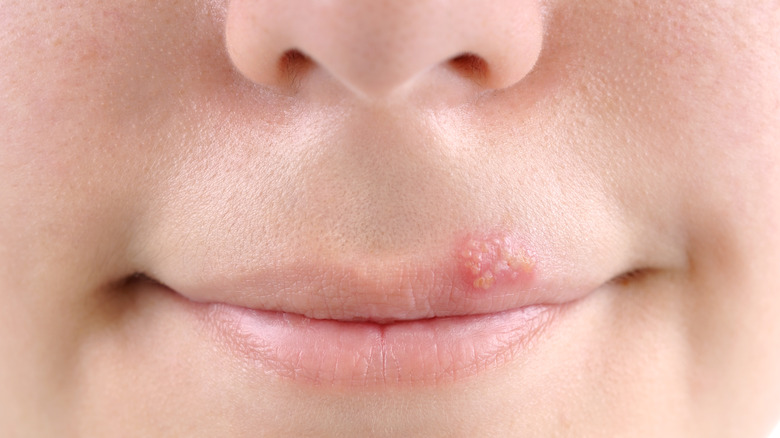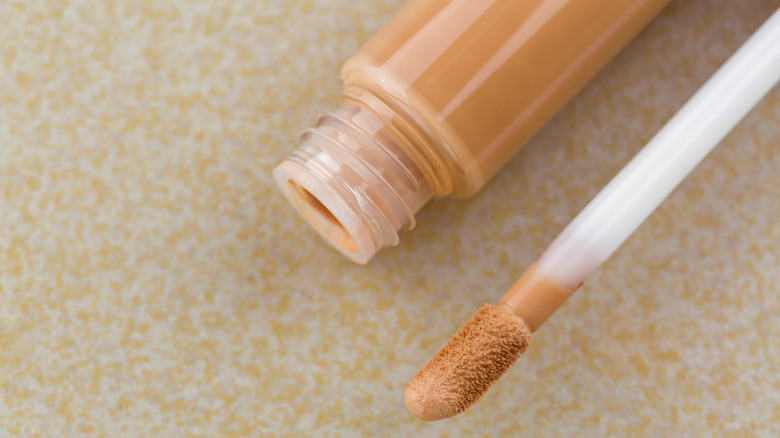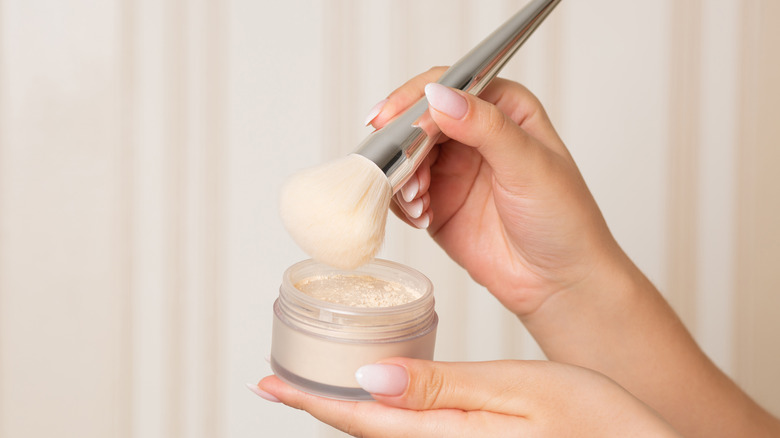Concealer Isn't The Only Makeup Item That Trumps Cold Sores
Few feelings strike dread into the heart quite like the first tinglings of a cold sore. Not only are they painful and annoying, but they're also incredibly unsightly. It's not just a one-day-only event, either. The typical cold sore can last up to 10 days, per Healthline, although in varying stages of oozy crustiness. Experienced sufferers know that a cold sore breakout is imminent when they start to feel the trademark sensations of burning, itching, and tingling on or near the lip. Cold sores can also present in the mouth, nose, or even the genital area, so avoid any kind of nookie until it's all cleared up, as the virus that causes them is highly contagious.
There's no shame in the typical cold sore, however. Commonly referred to as fever blisters, cold sores are a very common infection. They are most often caused by the virus herpes simplex type 1 (HSV-1), according to the Mayo Clinic, although HSV-2 is occasionally the culprit. When a cold sore appears, it's made up of a cluster of little blisters that are full of fluid. The misery isn't over even once the blisters are fully drained, however, as they then scab over, creating a whole new ugly effect.
Covering a cold sore takes finesse
There's no need to lock yourself away from the public eye during a cold sore's reign. A little know-how with makeup and moisturizer is all that's necessary to minimize its visual impact. First, it's vital to keep the area hydrated to make it easier to cover with makeup (not to mention, it facilitates the healing process). WebMD suggests lip balms, aloe vera gel, and even honey for this purpose. It might be tempting to "dry it out" while the blisters are draining, but keeping it moist will actually help it to heal more quickly. Do avoid putting makeup on the sore during the early oozing stage, however. This can actually make the little bugger stick around longer.
Once the sores have stopped oozing it's fine to proceed with some well-placed makeup coverage. Start by dabbing some concealer or foundation using a disposable, moist makeup sponge, cotton swab, or makeup brush that you don't want to keep. Abreva suggests a "highly concentrated" concealer that is both creamy and thick. A green or yellow-based concealer is especially adept at reducing redness. Then, top it off with a concealer in your normal shade. Gently blend and repeat as needed until the sore is sufficiently covered. It's ultra-important to note that all tools and products applied directly to the site should be thrown out after each use; otherwise, you risk getting another cold sore down the line.
The finishing touches when covering a cold sore
Once the concealer and foundation are adequately blended, top it off with a light layer of makeup powder to help it set. Then, select a tinted lip balm or lip gloss and apply it to the entire lip. Definitely choose something on the moist side. Matte lipsticks are not your friend during this stage, as they'll dry the sore out and reveal visible cracks. Nothing's going to make the cold sore disappear entirely, but a practiced makeup hand will definitely minimize the damage.
The early days of a cold sore are critical, as how the issue is handled will affect how long it lasts, and how effective your makeup is. Pain and swelling are common side effects of cold sores, and can affect the coverage process. If you're experiencing either of those side effects, apply a cold compress to the area before attempting makeup, WebMD suggests. Then, treat the area with an over-the-counter medication or prescription designed specifically for the job. This will shorten the lifespan of the cold sore and make it easier to cover. Abreva and other cold sore-specific products are also out there for purchase, or the doctor can prescribe an anti-viral. Most cold sores go away on their own without physician intervention, though, so that's one positive side to them!


